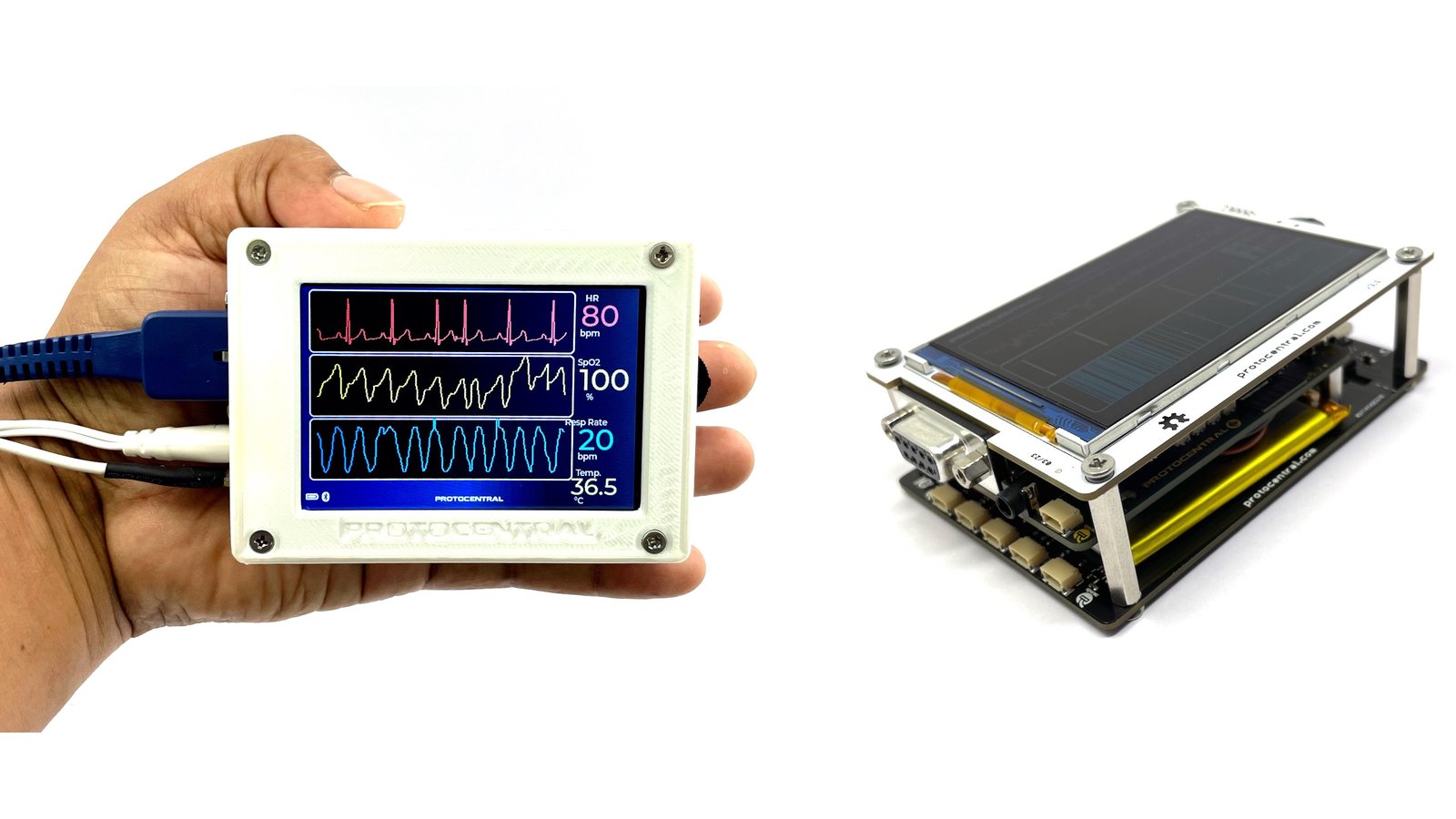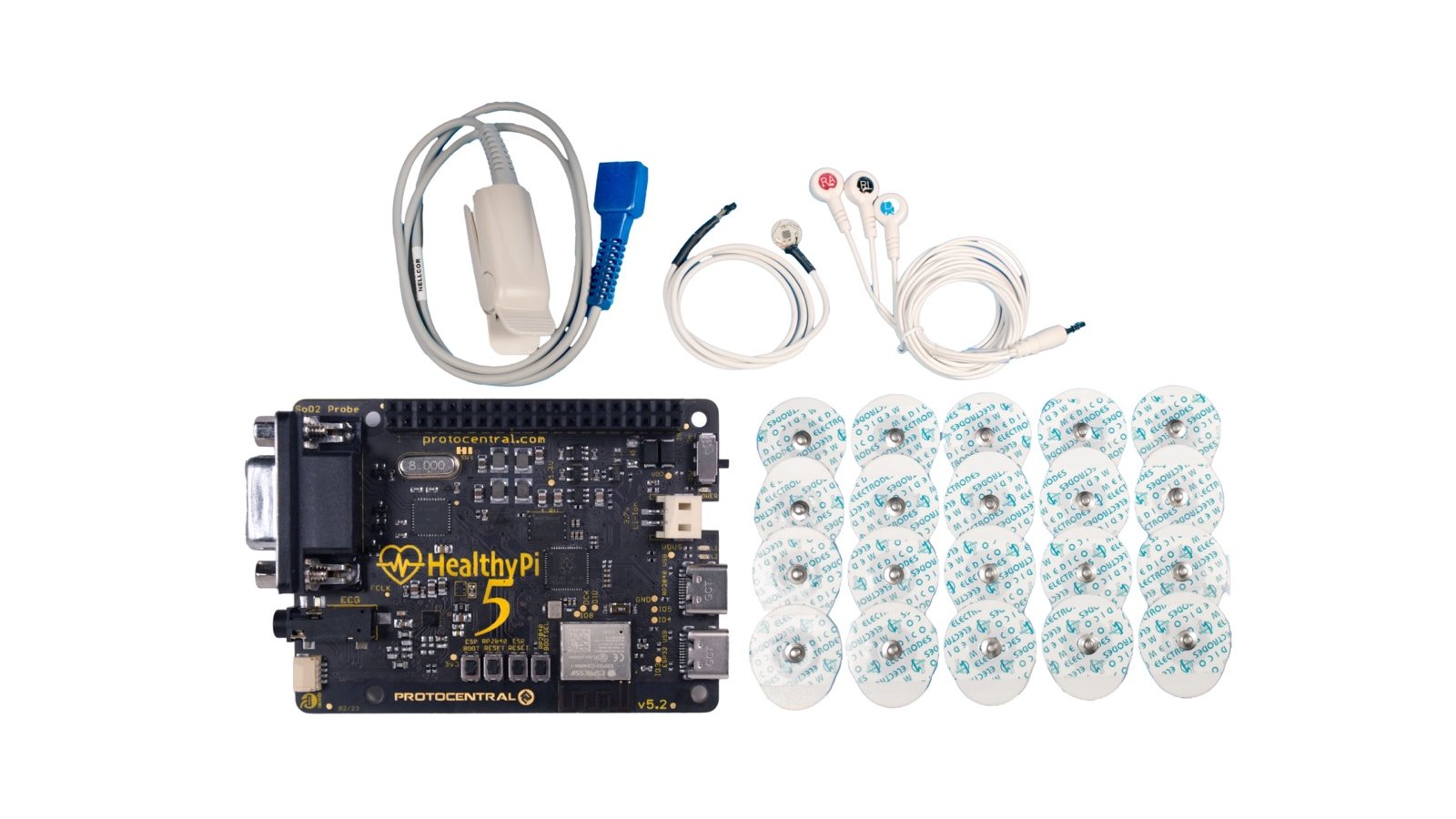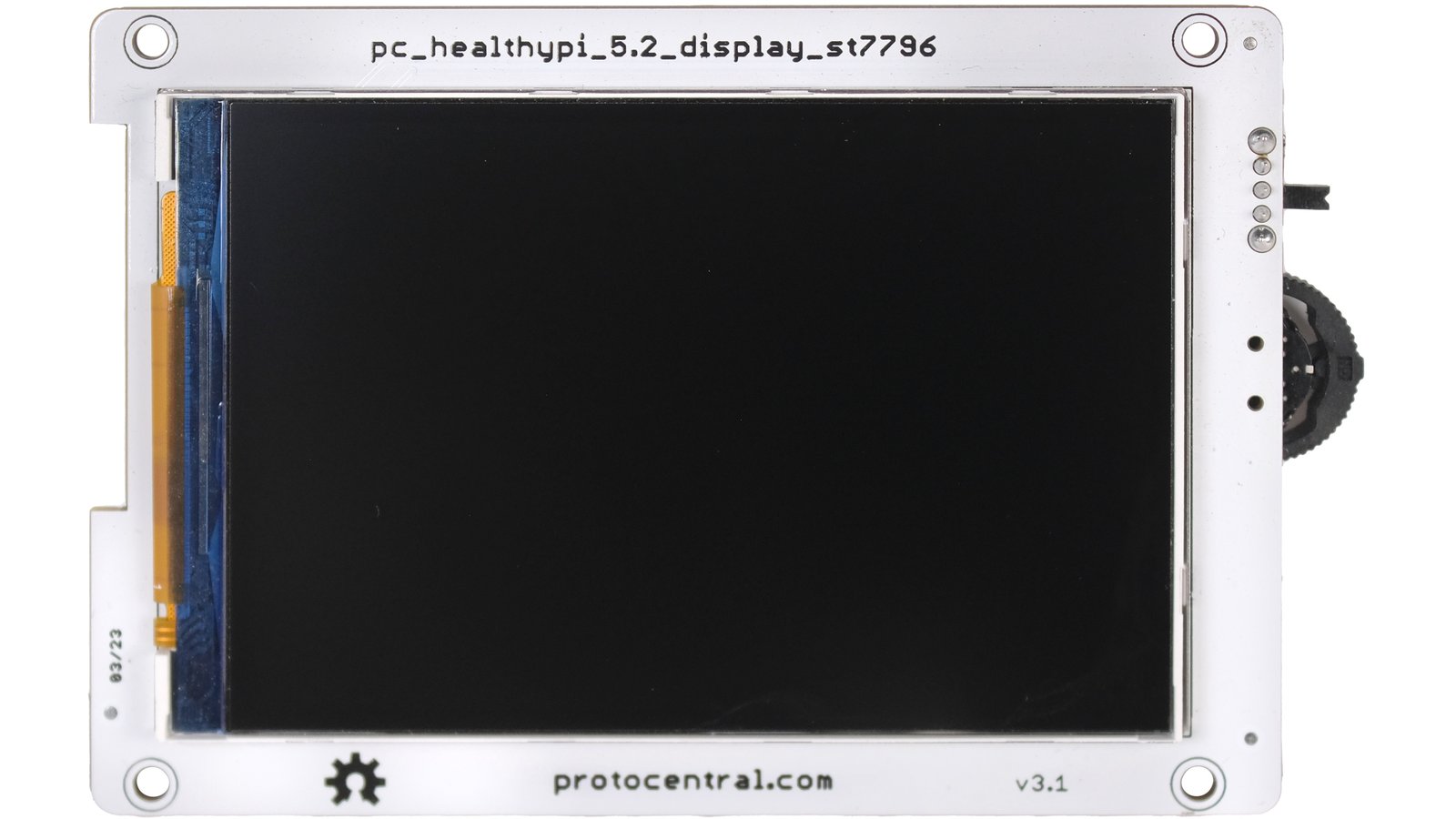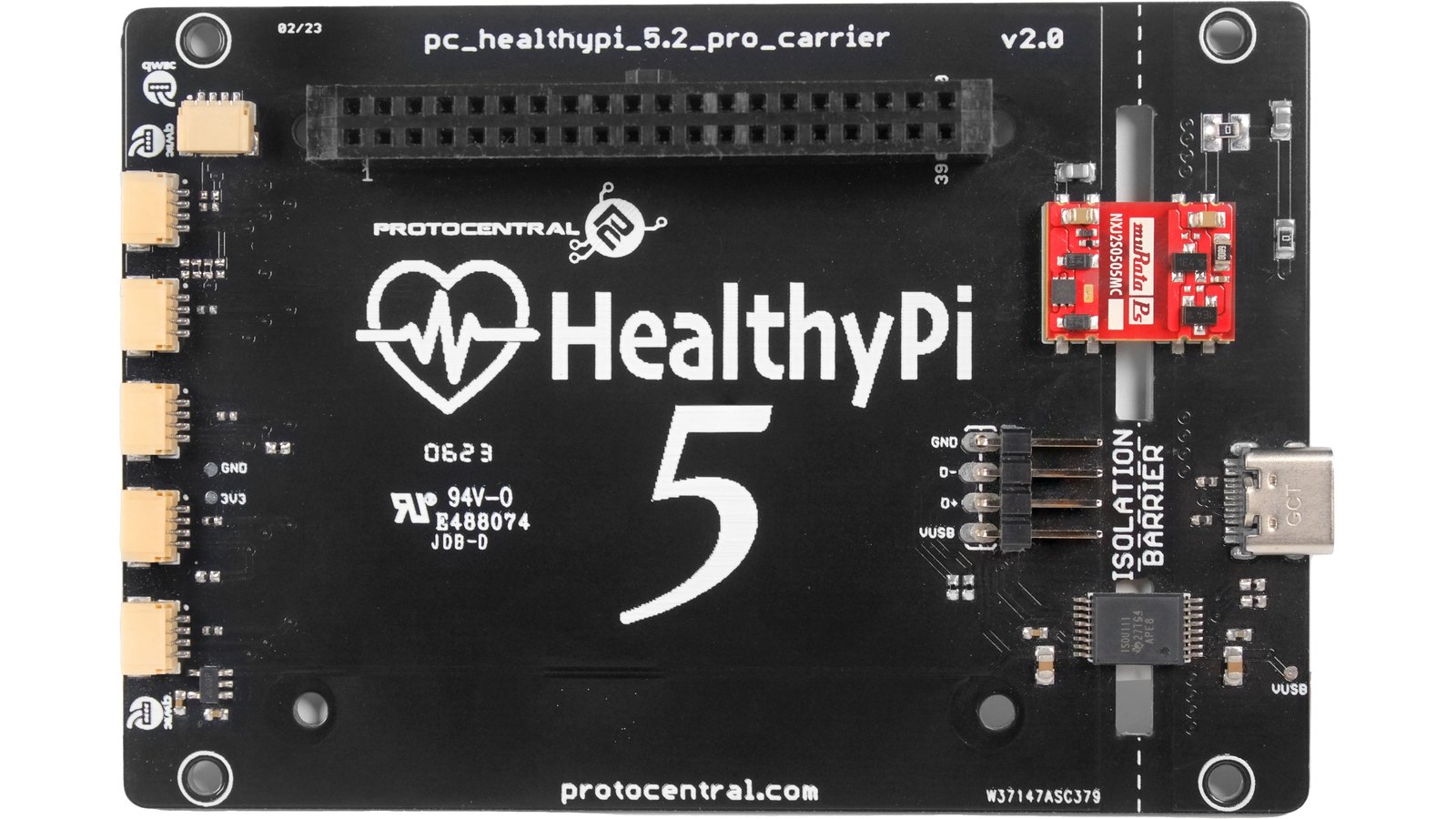ProtoCentral Electronics Private Limited
Bluetooth
Zephyr
ProtoCentral Electronics Private Limited
Bluetooth
Zephyr
HealthyPi 5 is a unique, open-source, biosignals-acquisition device that combines the power of a Raspberry Pi Pico with the simplicity of an Arduino. Whether you need a simple monitor for a specific vital sign or a complete health-sensor platform, HealthyPi 5 is an extensible solution to your health-data challenges. Out of the box, it can handle electrocardiogram (ECG), respiration, photoplethysmography (PPG), oxygen saturation (SpO₂), and body-temperature data. And it’s easy to upgrade as well! Using the Qwiic connectors on the Carrier board, you can leverage external sensor modules to capture and analyze additional biosignals, such as galvanic skin response (GSR), electroencephalogram (EEG), and electromyogram (EMG) data.
With an innovative, dual-microcontroller configuration—including both a dual-core, 32-bit, Cortex-M0+ RP2040 and an ESP32 C3 RISC-V module—HealthyPi 5 is suitable for a wide range of deployments, including machine learning applications that target physiological signals. And, with both Wi-Fi and BLE connectivity, it is easy to connect your application to other devices and to the Internet.
Previous generations of HealthyPi have been deployed for applications such as the unattended collection of vital signs, COVID-19 data logging, clinical trials, impromptu health-monitoring stations in rural areas, and maternal-health programs in the developing world, to name just a few examples.
HealthyPi 5 has a Raspberry Pi RP2040 dual-core, Cortex M0+ microcontroller at its core, supported by an ESP32 C3 RISC-V microcontroller that handles the wireless protocol stacks. The RP2040 is the first microcontroller built on the new Raspberry Pi silicon. It is a powerful, low-power microcontroller that can handle complex computing tasks, while the ESP32 C3 is a low-cost, low-power, RISC-V microcontroller perfect for managing Bluetooth and Wi-Fi.
Both the RP2040 and the ESP32 C3 are supported by the Arduino IDE, making it easy to develop applications for HealthyPi 5. They are also supported by MicroPython. If you’re feeling adventurous, you can also develop applications for HealthyPi 5 in C/C++ using the Raspberry Pi Pico SDK for the RP2040 or the ESP-IDF SDK for the ESP32 C3.
HealthyPi 5’s power management is handled by a set of discrete circuits for each function, such as battery charging, regulation, and power-path management. We made this design decision in response to recent supply-chain issues facing power management ICs, and it will make it easier for us to change suppliers if necessary.
Our Carrier is an add-on board for HealthyPi 5 that performs the function of isolating the power and data lines of the USB interface. This is done to ensure that HealthyPi 5 is safe to use when connected to the body. This board provides galvanic isolation of up to 1 kV between HealthyPi 5 and the USB host, according to IEC 60601 standard recommendations. The carrier also adds five Qwiic ports for attaching external sensors and modules. In addition to acting as a safety barrier, using the carrier board will also result in significant reduction of power-line noise (without the need for digital filters), which can help improve the quality of signals acquired.
Our Display module is an add-on board with a 3.5", 480x320 color TFT display for visualizing signals. It is designed to support either an ST7796 or an ILI9348-based module, depending on availability. The Display module also includes a side-actuated three-way navigation switch with a push function for one-finger navigation of menus, without being afraid of a touch screen breaking.
HealthyPi 5’s software consists of the firmware, the desktop GUI, and mobile apps for Android and iOS. The firmware runs on the RP2040 and ESP32 C3 microcontrollers and is responsible for data acquisition, storage, and wireless transmission. The desktop GUI runs on a host computer and can be used to visualize and record data. The mobile apps allow you to configure HealthyPi 5 and view data sent to your mobile phone over Bluetooth.
Our firmware, for both the RP2040 and the ESP32 C3, is written in C/C++ using the Arduino IDE. It is open source and available on GitHub, so you can modify it to suit your needs or use it as a starting point for your own custom firmware. You can use the Arduino IDE to compile and upload your firmware to HealthyPi 5’s RP2040.
If you do not want to write code for two microcontrollers, you can just use the ESP32 C3 as a Wi-Fi and Bluetooth interface for the RP2040. All primary data acquisition and processing is performed by the RP2040, so that is the only code you will need to edit to change the way in which data is processed, stored, or displayed.
We also provide pre-packaged firmware images for the RP2040 that you can use for common applications such as streaming data over USB, driving the Display module, etc. These images will also be available on GitHub. The RP2040 (Raspberry Pi Pico) interface provides a convenient USB Mass Storage Device interface for transferring files to and from the RP2040. This makes it easy to upload firmware images. All you need to do is copy the firmware image (in the form of a UF2 file) to the root of the USB Mass Storage Device, and the RP2040 will automatically load it.
Our desktop GUI is an open-source application, available on GitHub, that can be used to configure your device, receive data streamed over USB, and visualize data or record it to a file. It is written in Processing and, thanks to the Java programming language, it compiles natively for Windows, Mac, and Linux. The desktop GUI also supports streaming data over the local network using the popular Lab Streaming Layer (LSL) protocol, which is used in many research settings. Using LSL, you can share data with other applications and platforms—such as MATLAB or Python—and integrate your HealthyPi 5 data with other streams from other devices.
Our open-source mobile apps are written in the Dart programming language and, thanks to the Flutter framework, they compile natively for Android and iOS. You can use them to configure your device or to view data on a Bluetooth-connected mobile phone. The HealthyPi 5 mobile apps will available on the Google Play Store and the Apple App Store, with source code hosted on GitHub.
The HealthyPi 5 platform supports various modes of operation to accommodate the quirks of your particular application. You can choose which expansion boards you need based on the nature of your project.
Use HealthyPi 5 as a standalone vital-sign monitor. Add a Carrier board, which provides isolation for the main USB interface, including both data lines and USB power, thanks to galvanic isolation barriers that conform to IEC 60601-1 safety standards. The addition of a TFT display allows you to visualize raw signals, processed data, in-progress computation, and analysis. Using the navigation button, you can choose to display all available data or improve clarity by filtering for a particular signal. And you can do so while simultaneously logging data to a memory card.
If you don’t need an onboard display, you can simply stream data to your computer through the onboard USB Type-C port. The Carrier board isolates data and power, giving you a safe, quiet logging solution. When the data reaches your computer, our desktop GUI software allows you to visualize it, store it in a file, or use the LSL protocol to share it with other devices. Thanks to this LSL compatibility, HealthyPi 5 is suitable for use in clinical research deployments that require real-time synchronization of signals between various devices such as eye trackers and EEGs.
HealthyPi 5 includes an onboard MicroSD slot and support for Wi-Fi and Bluetooth connectivity. As a result, it can be used as a standalone data logger, and for wearable applications, even without a display or host computer. Both raw data and computed values can be stored on a MicroSD card or streamed in realtime to the HealthyPi 5 mobile apps. Logged data can be shared with other Android or iOS apps as needed.
HealthyPi 5 can also stream realtime electrocardiogram (ECG), respiration, photoplethysmography (PPG), and temperature signals to an application running on the attached Raspberry Pi. It maintains compatibility with previous (v3 and v4) HealthyPi generations by following the same Raspberry Pi HAT specifications. As a result, you can use a Raspberry Pi 3 (or above) single-board computer to process data using our desktop GUI or some other framework, such as Python, that runs on Raspberry Pi OS.
The HealthyPi 5 Carrier board is Qwiic compatible. Sparkfun Electronics introduced the Qwiic system of two-wire I²C connectors and cables to make working with external sensors easier. They also sell a a large selection of Qwiic-compatible sensors, including accelerometers, gyroscopes, magnetometers, and modules for GPS, temperature, humidity, pressure, and light.
The five ports available on the HealthyPi 5 Carrier board make it a "Qwiic Hub." Incorporating a new sensor is as easy as plugging it in and adding its driver to your program in Arduino. And, because the Qwiic interface supports daisy chaining, you can even have more than five sensors in operation at the same time!
| HealthyPi 5 | MySignals | BIOPAC MP160 | |
|---|---|---|---|
| Primary CPU | RP2040 dual-core ARM Cortex M0+ | Unknown (Proprietary) | Unknown (Proprietary) |
| Co-processor | ESP32 C3 RISC-V | Unknown (Proprietary) | Unknown (Proprietary) |
| Number of built-in parameters | Four basic vital signs | 20 (all add-on modules included in kit) | 16 channels (can be configured for different signals) |
| Add-on parameters | 10+ via Qwiic or I²C add-on sensor boards | None | Biopac amplifiers & proprietary devices can be daisy chained |
| Connectivity | Wi-Fi, BLE, and USB | Wi-Fi, BLE, and USB | Wired only |
| Mobile app | Android & iOS (open source) | No | No |
| Onboard data storage | Yes | Yes | No |
| Interoperability | Open data format & support for open APIs like Lab Streaming Layer (LSL) & Brainflow | Open data format | Open data format |
| Form factor | Handheld or tabletop (10 x 7.5 x 4 cm with display & carrier board) or wearable (5.6 x 6.5 x 3 cm with battery) | Depending on modules in use (base unit 15 x 10 x 7 cm) | Tabletop (10 x 11 x 19 cm) |
| Open hardware | Yes | Partially open | No |
| Open source software | Desktop software, Android app, and iOS app (MIT License) | Software provided without source code | User-licensed software only |
| Product design extensibility | Hardware optimized to support your own product designs | No | No |
| Price | $299 to $425 | ~$3000 | ~$7500 for base system & a single software license |
HealthyPi 5 is open hardware powered by open-source software and supported by a vibrant community of developers, which means you can use it as a foundation upon which to build your own products and services.
All of our software—including our firmware, desktop GUI, and mobile apps—is open source under the MIT license, which means you are free to reuse and modify it, even for commercial purposes. You will find it on GitHub. In additional to the source code, we will also provided pre-compiled binaries for the HealthyPi 5 firmware and desktop GUI.
The following are the open source projects that we used when developing HealthyPi 5:
All of our hardware design files—including schematics, the BOM, and our PCB layouts—are open source and will be available in our GitHub repository once the campaign is live. We designed the HealthyPi 5 hardware using Eagle, a free version of which is available for anyone who wants to modify our designs. We will also publish the 3D-printing design file for our enclosure so you can print your own if you so choose.
Getting started guides, tutorials, and pre-campaign status updates are available on our website. You can reach us using the Ask a question link below.
We have an on-site manufacturing facility that we can use to assemble and test HealthyPi 5 hardware, and our Bangalore-based team has a great deal of experience with hardware assembly, testing, and inspection. We purchase components from Mouser, Espressif, Maxim (Analog Devices), TI, DBi-Key, and other well-known suppliers. This helps us guarantee quality, consistency, and reproducibility. Finally, we have run four previous Crowd Supply campaigns: HealthyPi v4, HealthyPi v3, HeartyPatch, and Sensything. All four were successfully funded, manufactured, and shipped to backers.
We will provide a PLA 3D printed enclosure along with the full kit. The enclosure is designed to fit HealthyPi 5, the Carrier board, and the Display module. (You are of course free to print your own enclosure, as well, using the 3D model we will publish on our GitHub repository.)
Although HealthyPi 5 has many of the features of a medical-grade patient-monitoring system, it does not have any medical certifications (FDA, ISO, etc.) and is not officially approved for medical or diagnostic use. When using this device, it is your responsibility to ensure your safety and that of others.
"While the HealthyPi 5... follows the Raspberry Pi HAT form factor and can be connected to a Raspberry Pi SBC to analyze the data, it can also be used as a standalone device with the processing handled by the RP2040 dual-core Cortex-M0+ microcontroller."
"The HealthyPi 5 is a new system that is designed to be particularly easy to record various vital data. The system is open source and therefore highly customizable and expandable."
"[T]he HealthyPi 5 [is] an open-source, biosignals-acquisition device that combines the power of a Raspberry Pi Pico with the simplicity of an Arduino."
Produced by ProtoCentral Electronics Private Limited in Bengaluru, India.
Sold and shipped by Crowd Supply.

HealthyPi 5 Complete Kit is a fully assembled HealthyPi 5, including our Mainboard, our Display module, our Carrier board, a 3D-printed enclosure, and a 3.7-V / 2000-mAh LiPo battery. Comes with an ECG cable, ECG electrodes, an SpO2 probe, and a temperature-sensor cable.

HealthyPi 5 Mainboard with core sensors for ECG, respiration, SpO2, and temperature. Includes our Main Board, an ECG cable, ECG electrodes, an SpO2 probe, and a temperature-sensor cable

Add-on display module for HealthyPi 5. Includes a 3.5", 480x320 color TFT display for visualizing signals and a side-actuated, three-way navigation switch with a push function for one-finger navigation of menus

Add-on carrier board that provides power and data isolation as well as five Qwiic-connector ports for adding sensors. Includes a USB Type-C adapter board that connects the Carrier to your HealthyPi 5

· Protocentral · protocentral · protocentral@mastodon.social · protocentral.com
ProtoCentral is an open-source hardware design, development, and manufacturing company based in India. We are strongly committed to the development of open source hardware. Most of our products are open source and anyone is free to re-use them for their own projects. We are also working toward open sourcing more hardware, especially for the medical and biotech domains.